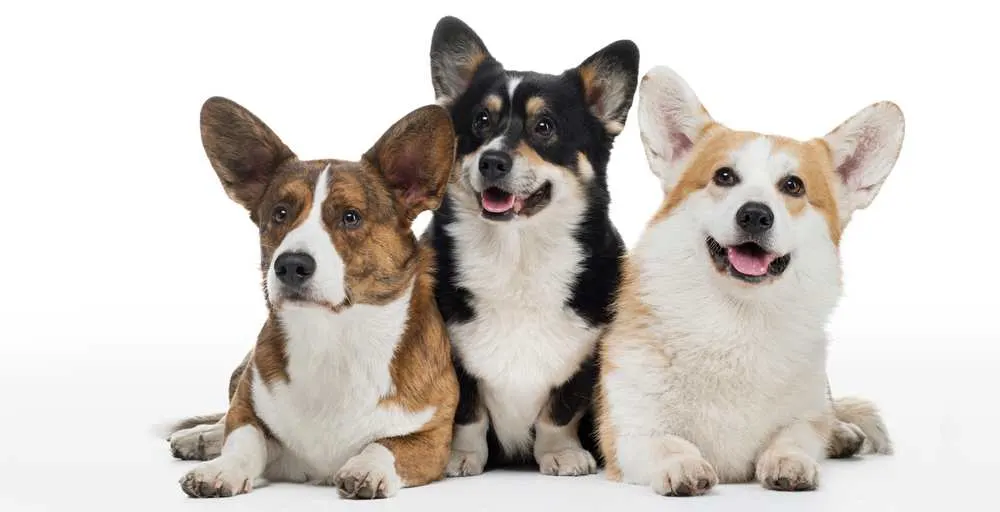What dog breed has a short stature, prick ears, fluffy butts, and looking like a fox?
Yes, you are right, I am talking about Welsh Corgi! I am sure most of you out there have heard about this adorable dog breed or have seen one.
Corgi dogs are simply adorable; I mean, look at those short legs and those cute little paws. Have you noticed how they wiggle with their fluffy buts? I simply can’t resist them.
Welsh Corgis are mostly known for their cuteness, but they are also very intelligent as well as stubborn. You must expect that life with corgo doggo is not boring at all, they are very feisty, and they need regular exercises.
This might surprise you considering their size, but these little munchkins are packed with energy. Have you ever wondered how long are Welsh Corgis? If you did, you will love this article since it is time to focus on them and learn all about Corgi size.

Welsh Corgis At A Glance
| Pembroke Welsh Corgi | Cardigan Welsh Corgi | |
|---|---|---|
| Height: | 10 to 12 inches | 10 to 12 inches |
| Weight: | Males up to 30 pounds Females up to 28 pounds | Males up to 38 pounds Females up to 34 pounds |
| Length: | 22 to 26 inches | 36 to 43 inches |
| Lifespan: | 12 to 13 years | 12 to 15 years |
| Energy level: | High | High |
| Exercise needs: | 20 to 40 minutes per day | 20 to 40 minutes per day |
| Intelligence: | High | High |
| Tendency to bark: | High | High |
| Tendency to dig: | Medium | Medium |
| Shedding: | High | High |
| Overall grooming needs: | Low | Low |
| Pet-friendly: | Medium | Medium |
| Trainability: | Medium | Medium |
Are corgis considered small or medium dogs? This is the question that confuses many potential corgi dog owners. Let’s learn a bit more about them in general and see what breed standards will tell us.
First thing first, there are two different Welsh Corgis types – Pembroke Welsh Corgis and Cardigan Welsh Corgis. There are some obvious differences between these two types of herding dogs, yet people often confuse them.

Pembroke Welsh Corgi Vs. Cardigan Welsh Corgi
They do look alike, that is true, but there are some differences that I will point out today so you will know how to differentiate them from now on.

Heritage
These cuties do not share the same ancestor. I know it sounds weird, but they actually come from two different areas from Wales. The Pembroke’s come from southern Wales, where the terrain is flatter and easier to cope while Cardigan’s comes from southwest Wales’s rocky and rough terrain. The Cardigan species is over two thousand years older than the Pembroke species.
The Cardigans originate from the same ancestor lineage as Dachshund, and that’s the German Teckel lineage. They came to Wales with Celtic tribes somewhere around 1200 BC.
On the other hand, Pembroke Corgis were brought by Vikings somewhere around 1000 AD; they are descendents of Nordic Spitz breeds.

Physical Differences
Physically they are very similar; they both belong to a dwarf type of dog with long heavy bodies, big heads, and short thick legs.
Coat
Both corgis have a thick double coat that needs regular brushing and bathing.
The coat is medium length, short, thick, with a weather-resistant undercoat with a longer outer coat. The coat is slightly thicker and longer around the neck, chest, and shoulders. The body coat lies flat and preferably straight, but some waviness still occurs. On the other hand, wiry, fluffy, or overly short are faulty.
The coat’s color is also the safest way that will tell you if corgo doggo is from Pembroke or Cardigan lineage. Pembroke Corgis only come in sable, red, and tricolor with white markings.
Cardigan Corgis come in red and sable with white markings, brindle, black and white with brindle or tan points, and blue merle. The white markings are less restricted in Cardigan Corgis than the Pembroke Welsh Corgi.
Tail
The easiest way to differentiate Pembroke from Cardigan Corgi is to look for a long fox tail or the absence of a tail in Pembroke’s case. Also, Cardigans have larger and rounder ears than Pembrokes.
Weight And Length
Cardigans are a bit larger with heavier bone. Male Cardigans typically weigh up to 38 pounds, and Pembroke males do not go over 30 pounds if not overweight, of course.
So how long are full-grown Corgis? Well, the basic body structure is significantly different. Pembroke Corgis have oval bone and a squared rear, which gives them a more linear and rectangular look, and their approximate body length is between 22 and 26 inches.
On the other hand, Cardigans are curvier hence their round bone and sloping rear, but they are a bit longer than their cousins, which is expected due to their long fox tails.
So how long are Cardigan Corgis? Well, somewhere between 36 and 43 inches from their nose to the tip of the tail.
Height
What about height? How tall are corgis? Are corgis dwarf?
Both Cardi and Pem Corgis are short; to be more precise, they do not go over 10 and 12 inches in height. That must make you wonder do corgis have dwarfism. Well, technically, no, even though in Welsh Corgi means dwarf dog.
Many claim that Corgis are doggos with achondroplasia (a most common form of dwarfism among humans); others claim that they are suffering from hypochondroplasia.
They are not actually dwarfed; considering they still have normally enveloped bodies and heads, they are only short-legged. Dwarfism comes when bones do not grow normally, and that is not the case here.
All domesticated dogs with short, stunted legs result from the FGF4 gene, which was copied and reinserted into the dog’s genome sometime in early evolution. That means all short-legged dogs have two FGF4 genes instead of one.
Neck
How big are Corgi’s necks considering they are so miniature and tinny?
Surprisingly corgis have a fairly long neck. For example, most corgis have an average neck size from 14 up to 16 inches, while pit bulls have necks from 14 to 18 inches, so you get my point.
Very short or long and thin necks are faulty.
Head
Corgis look a lot like foxes, so, therefore, they should always have a foxy shaped head with an intelligent and interested expression. They are a breed with big why heads, so the skull should be fairly wide and flat between the ears.
Eyes are oval and medium in size, not round, nor protruding, usually brown for both Corgi types. Ears are always erect, firm, and of medium size. Pembroke Corgis have slightly smaller and pointer ears, while Cardigans have larger ears with a rounded point.
Ears are very mobile and sensitive to sounds.

Personality
Both species are energy bombs, joyful, and playful at all times. They are packed with good vibes and love, trust me! They adore kids, and they are happiest when spending time with their humans. They genuinely are big dogs on short legs!
The Corgis are well known for their quick intelligence, but training is essential. They are extremely obedient with pronounced enthusiasm and desire to work, so make sure you always give them something to do, or else you risk some home havoc. At least let them chase a ballie; you will be surprised how agile and fast these little puppers are.
Don’t forget Corgis are bred to be herding dogs, so you might find out that they will try to herd the smallest humans, but do not worry; this only means they are excellent guard dogs.
They are great family pets, but they can be very territorial with other dogs and cats, so consider if and when you decide to introduce a new pet member.
Pembrokes are more friendly, affectionate, and outgoing dogs, while Cardigans are less energetic, quitter, and more laid-back. Pembrokes are more always ready for party doggo’s while Cardigans are more Netflix and chill type of doggos. So choose your Corgi according to your personality.

Who Should Choose Corgi As A Pet And Who Should Not?
If you want and can handle a dog that has:
- Colossal personality and think he is a big dog on short legs than yes Corgo is your doggo
- Long, robust body, and it is low to the ground
- Working dog temperament
- Athletic spirit yet needs only moderate exercise
- Easy to groom coat
- A guard dog quality, however, it’s very friendly and polite with guests
But in case you don’t want to deal with:
- Need to provide enough mental and physical stimulation so your dog doesn’t go crazy
- Destructiveness caused by boredom or when they are left alone too long
- Territorial aggression toward unfamiliar dogs and cats
- Stubborn doggo with a mind on his own (confident owners only!)
- Lots, I mean lots of barking and talking
- Constant chasing and nipping on everything that moves
- Shedding in larger amounts

How To Breed Welsh Corgis?
Breeding Corgis is harder than you think! In the last few decades, people all around the world became crazy over Corgis and their fluffy butts.
The main reason why they are so popular is their cuteness and how smart they are. Queen Elizabeth II’s love for this breed only enhances their popularity. The interesting fact is that Corgis were listed as the 24th most popular dog breed in America in 2013, today they are ranked 10th!
Like always, excessive breeding caused by increased popularity is never good news. Selective breeding is complicated, and in most cases, it ends up wrong. Unethical breeders will exaggerate as usual and try to produce Corgis that are smaller than they should be; some will even try to go for teacup size.
Why?
Well, the main reason is the general public does not have any knowledge about breed standards, and the only thing they see is cute fluffy doggo that would be even cuter if it was miniature in size.

How Big Are Corgi Litters?
Average Corgi litter will count from six to eight pups, and sometimes this number can go up to ten, but that’s rare. Corgis are generally easier to work with compared with other small dog breeds, but like with every small dog breed, C-sections may be required at times, and I will talk about that a bit later.
Let’s take a quick look and find out what can affect the size of the litter.
What Determines Litter Size?
First and most important is a dog breed. Logically big dogs have larger litters since they are able to carry more puppies safely.
For example, a Labrador retriever can carry from five to ten puppies without any risk and complications. On the other hand, Yorkie or Chihuahua can only manage from two to five puppies safely. As already mentioned, a Corgi litter usually counts six puppies.
But there are some exceptions; for instance, Pekingese can carry up to ten puppies, and they weigh less than Corgis! There is always a risk with bigger litters since it can end up fatal for a female if she becomes exhausted during the labor. Also, there is a bigger chance for puppies to be delivered stillborn in larger litters.
Age also plays a prominent role in a dog’s litter size. The older the female, the smaller is the litter. This mainly considers larger breeds. Females that are between two and five years will have larger litters, although the first two litters will always be smaller.
The age of a male dog is crucial as well since males older than five years have less quality sperm.
High-quality nutrition rich in protein will maximize the chances of having a bigger litter. But be careful since overweight female dogs have fewer chances of forming larger litters.
What about genetics? Do genetics play a role in the determination of litter size? Well, not so much, since genetics mainly affects the size, coat, and eye color.
Can Humans Affect Litter Size?
Humans have control over when and how a female dog is bred, and that can affect litter size. Yet there is a limit, of course. If a female dog is artificially inseminated, the litter will be smaller.
This is logical since. Also, litters born in the spring are usually larger than litters born in other times of the year.
Now let’s focus on puppy talk.

Puppyhood Stages
The neonatal stage considers the first four weeks of the puppy’s life, and they are quite fragile in this period.
- Week One – Puppies are deaf and blind and, on top of all, unable to regulate their own body temperature. It is crucial for them to stay warm at all times in the first week, and they must be fed every 2 hours! Breeders will weigh them two times per day, and in case they dropped some weight, they will be fed with milk supplement formula.
- Week Two – Since puppies are born without pigment this week, they will start showing off their colors. Weight is still checked two times per day. Somewhere around day ten, they will start developing their eyes and ears.
- Week Three – Finally, this week, they can hear and see! They will slowly start to move and explore since eyesight and hearing will encourage them. This is the week when they will try their first solid food meal in the form of formula. Usually, this is the perfect time for deworming.
- Week Four – Seven – Puppies now can regulate their body temperature, so they are ready to move into a more spacious box. It is time to introduce a variety of dishes for eating and drinking now so they can get accustomed to. They will start socializing, playing with toys, and getting familiar with a human touch.
During the first four weeks, puppies should spend most of their time with their mother and siblings. It is unusual for owners to care for them during this time since they need the mother’s milk to get all the necessary nutrition during this neonatal stage. Their body will double in weight as their muscles, organs, and bones develop in this period.
After the neonatal stage, it is time to take your puppy home; the earliest is when they are eight weeks old.
How big are puppies at eight weeks, you must be wondering? If they are properly neutered, they will weigh around 8 or 9 pounds. Remember, they grow very quickly, and they will gain at least a pound per week.
While a large-breed puppy multiplies its birth weight 100 times in his first year of life, a small-breed pup will multiply his birth weight 20 times. If we do simple math, we can easily find out:
- How big are corgis at three months – the answer is between 9 and 12 pounds.
- How big are corgis at four months – approximately 15 pounds.
When puppies reach six months, it will be easier to differentiate between females and males since girls will be smaller.
An average six-month-old female will have 20 pounds, while the average male will have around 22 pounds.
So the next question is:
When do corgis reach their full size?
As I already said, they grow insanely quick, gaining a pound per week and the average weight for Pem Corgi is around 30 pounds, while Cardi Corgi is usually heavier and will weigh 38 pounds. This means you can expect your Corgi to reach its full size somewhere between the 11th and 13th month of its life.
Too fast, ain’t it? It is hard to watch your puppy grow so quickly since we would all love to enjoy their mischievous puppyhood as long as we can, but you must keep in mind that eventually, they will grow, and if they reach their full size by this time, that is a sign of a good healthy pup.

C-Section And Corgi Females
As I promised earlier, I will talk about the caesarian section.
Rates of C-sections in Corgis are high. Some comprehensive research showed that C-sections in Pembroke’s reach 37%, and that rate is a bit lower for Cardigan’s and go around 21.8%. These numbers are pretty high, but that has to be expected since their pelvis is too narrow for a natural delivery.
There are some other causes of the high rate of C-sections in Corgis, and they can primarily be related to uterine inertia or the presence of a dead puppy in the litter. Many breeders like to play safe, so they choose C-sections over natural delivery, which is understandable, especially if there are more than six puppies or if they appear bigger than they should be.
Some risks are linked with C-sections.
The first is called Dystocia.
- This condition is a cause of a large number of C-sections, and unfortunately, it is not so uncommon in breeds that have larger heads in proportion to their bodies. Logically, both Welsh Corgi species are at particular risk of having this problem since, in most cases, females’ reproductive tract is too small to whelp the puppy.
The second case is Stalled labor, or also known as primary inertia of the uterus.
- This is a condition in which the uterus is lazy and does not produce contractions that are strong enough to deliver the puppies – when this happens, the only solution is a C-section. This condition is hereditary in Welsh Corgis.
Unfortunately, Welsh Corgis as well have high chances of false pregnancy. To be more accurate, it is 18% for Cardigan Corgis and 19% for Pembroke Corgis. They can also experience irregular heat cycles, infertility, pyometra, and cryptorchid in males (absence of one or both testes).
False pregnancy will appear a month after the heat cycle, and you shouldn’t be worried since it is not dangerous to females. The main cause is unknown yet, but it is related to the imbalance in progesterone and prolactin hormones.
The signs are abdominal distention, enlarged mammary glands, restlessness, and need for nesting.
See Also: How Often Can Corgis Have Puppies?

What Are Genetically Health Concerns When Breeding Welsh Corgis
The average lifespan of Corgis is between 11 and 15 years, and they are generally healthy breeds. Of course, there are some concerns about health issues that can occur when breeding is not done properly, so let’s find out more.
1. Degenerative Myelopathy
Some statistics show that the number one concern for breeders should be degenerative myelopathy. Degenerative myelopathy is incurable for now without any sign of a cure. This disease strikes dogs when they are around eight years old.
The disease starts when a dog gradually loses control of its limbs. After that, it will start losing control over the bladder and bowel. Dogs that suffer from this disease become paralyzed and die in six months up to three years. The rates for carriers of this disease in both Corgi species are over 30%! No dog that is a carrier of this disease should be bred!
2. Von Willebrand’s Disease
This is a genetic type of disease that causes excessive bleeding due to a lack of a specific protein that has a clotting factor. Unfortunately, dogs that have this disease bruise very easily.
The problem is that this disease can be noted after surgery or after some injury occurs, so dogs can potentially bleed to death if there is no available medical attention.
Do not get me wrong; dogs can normally live with it and will reach their average lifespan if you always make sure to get medical attention on time. An autosomal recessive gene causes the disease, and there always must be two of the genes, so this gene can develop.
3. Heart Disease
Welsh Corgis are susceptible to a condition called patent ductus arteriosus. In this case, a small vessel that carries blood between two different parts of the heart does not close properly, and this occurs shortly after birth.
This disease results in too much blood being carried to dogs lungs, where it causes fluid build-up and heart strain. This problem’s signs may be mild or severe, and it includes coughing, shortness of breath, fatigue, weight loss, and weakness in the hind limbs. Surgery is the only solution.
4. Back Problems
Intervertebral disc disease is a common condition in dogs that has long backs and short legs like Corgis. This condition is caused when the cushion between one or more vertebrae slips or ruptures; when this happens, a disc presses on the spinal cord, which can cause severe pain.
If you notice that your dog is unable or unwilling to walk, jump, go on stairs, has a hunched back, cries out, or refuses to eat or go potty, he is likely to experience discomfort and possible paralysis! Visit your vet immediately; do not wait; in case of a sudden paralysis, surgical removal of a ruptured disc is a must. For less severe cases, rest and medications are a solution.
Corgis tend to put some extra pounds with ease, which enhance the chances of IVDD significantly.
5. Hip And Elbow Dysplasia
Hips and elbows are at risk for dysplasia, especially as your Corgi matures since they are known to have stiff elbows. This condition is inherited, and it causes the joints to develop improperly, which later results in arthritis.
It begins to show with lameness and discomfort in legs or as difficult to get up when your dog is lying down. If you notice any of these symptoms, take your pet to your vet for an examination and X-rays. We can treat arthritis — the sooner, the better — to minimize discomfort and pain.
Arthritis is fairly easy to treat when it’s identified in the early stages. Keep your dog’s weight in check to avoid complications.
6. Kidney Problems
Glomerulo nephropathy is an inherited disease that slowly damages Corgi’s kidneys. This condition causes kidneys to fail, unfortunately, very often at an early age.
Early detection of this disease is crucial, so your pet can live a long and happy life with the right kind of therapy. It is easy to detect since damaged kidneys leak protein, so the clear sign of this condition is an excessive amount of protein in a dog’s urine.
Also, Corgis are prone to developing different types of kidney or bladder stones more than any other breeds. If your little buddy has blood in his urine, can’t urinate, or refuse to urinate, take it to your vet ASAP.
7. Liver Problems
Corgis are prone to a liver disorder called portosystemic shunt (PSS). This condition causes some of the blood supply to go around the liver instead of in the liver. This way, the liver is deprived of the blood flow it needs to grow and function as it should. This also means that the liver cannot remove toxins from the bloodstream effectively.
Symptoms are stunt growth or seizures, and if you notice them take your dog for a blood test.
8. Eye Problems
Unfortunately, Welsh Corgis can inherit or develop a number of different eye conditions. Some can even cause blindness if not treated properly.
The most common cause of blindness in older Corgis is a cataract. This condition will make their eyes look opaque and cloudy instead of clear. Surgery is needed to remove cataracts and restore sight.
Progressive retinal atrophy (PRA) is an inherited disease that is more likely to affect Corgis than other dog breeds. Unfortunately, in this case, eyes are genetically programmed to go blind, and it can’t be cured.
Dogs with this gene will first experience symptoms such as night blindness or dilated pupils somewhere around the third year. From this point, their eyesight will start to deteriorate significantly.
Distichiasis is a rare condition caused by extra hairs that grow inside of the eyelid or on the rub on the surface of the eye.
Of course, Corgis are prone to this disease more than any other digs (you see the trend here, right?), and if it’s untreated, it can cause corneal ulcers and chronic eye pain. Hair must be permanently removed.
9. Lymphoma
Lymphoma is a type of cancer that affects Welsh Corgis more than other breeds.
When a dog suffers from this type of cancer, its body forms abnormal lymphocytes (a type of white blood cell); lymphoma can be found anywhere since white blood cells are spread all over the body, but luckily this cancer is very treatable, and it has an excellent success rate in dogs receiving chemotherapy.
Watch for swollen glands, weight loss, or labored breathing at home, and take your dog for a blood test if you notice any of these changes.
10. Dermatomyositis
Dermatomyositis is a skin and muscle inflammatory condition that affects young Welsh Corgis. It is caused by a genetically passed defect in the immune system. That means that if one parent is affected, all the puppies will be susceptible to the disorder, and these dogs should not be used for breeding.

When Do Corgis Reach Maturity?
Your pup won’t reach maturity at once, and just like us humans, they transition from baby to adult in stages. Here’s what you need to take an eye on while your puppy is maturing.
- Sexual Maturity – Dogs become sexually mature when they’re still in the puppy stage of development, approximately around six months. This means your pup’s sex organs are fully developed, and they are capable of reproducing, but that does not mean they should! On the contrary, this is the best time to have your dog spayed or neutered if you decided that you won’t breed them.
- Physical Maturity – Dogs are fully physically grown by the time they’re one year old for smaller and medium breeds, while larger breeds are growing and developing until they’re two years old. No matter if your pup reaches physical maturity, it could still engage in puppy-like behavior. The only thing that will change for sure is the number of calories he needs to consume and how much exercise he requires.
- Emotional Maturity – When your dog stops acting like a puppy congratulation, your dog becomes emotionally mature! You’ll know when that happened since emotionally mature adults are less distractible and way calmer. Also, they are more obedient and less mischievous. The precise timing when this will happen is different for each individual, but it should usually appear after their second birthday.
Nutrition And Obesity
When your pup reaches adulthood, you will need to take care of their food intake and nutrition since Corgis are prone to gaining weight quickly.
This is a big concern for them since they have back problems, which will worsen if your bestie is overweight! Obesity will also shorten their life and open up the doors for many other health issues that are linked with putting up some extra weight like metabolic and digestive disorders, back pain, and heart disease.
Adult Corgis will need two meals. Each meal should consist of a 3/4 cup of dry dog food. The amount, of course, depends on the dog’s size, age, and activity level. Never leave food out in the open since these little munchkins will for sure go for it the minute they see it.
Read Also: How Long Do Corgis Take To Grow? Growth & Weight Chart

So You Think You Want A Corgi?
Oh yes, yes, you do!
Welsh Corgis are adorable, feisty little fellows that will accompany you in all your everyday adventures. Living with them is pure joy (if you train them properly, of course). They are easy to take care of; all they need is a bit of your attention and light exercises for their body and mind as well since they are miniature energy bombs.
They are hilarious! Seriously they are, and all thanks to their curious nature and their need to inspect everything, which usually leads them into some messy yet funny situation. This breed will, for sure, put a smile on your face even on the cloudiest days!
Welsh Corgis are super intelligent and social, and they firmly believe that the world runs around them, so do not try to change that since that is an impossible mission.
Lastly, when we talk about the size, if you ask them and if they could tell you, they will for sure reassure you that they are big dogs! But in reality, they are a cute bundle of joy that some people consider as a small breed while others think they are a medium size dog breed.
So if your question was – are corgis a small or medium dog? The only answer I can give you is – the decision is up to you.
I hope this article helped you learn more about this amazing dog breed, and if you were in doubt whether you should get Corgi or not, it assisted you in making a good decision.

